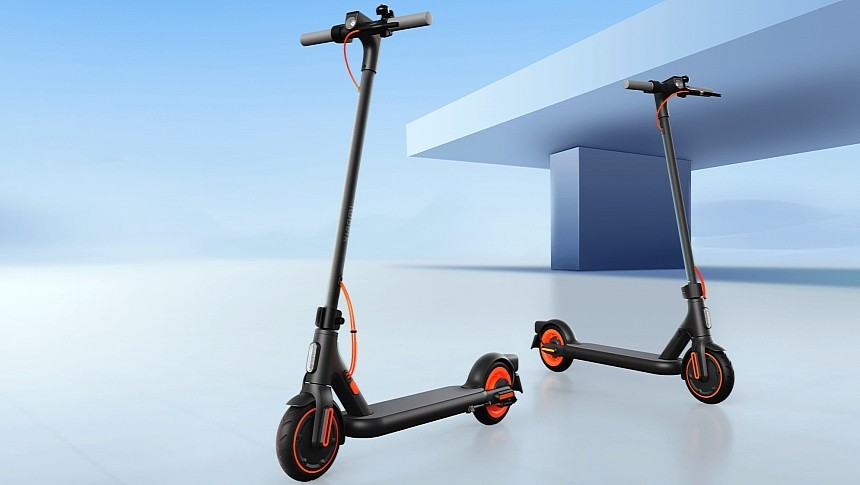Recent years have seen an explosion in last-mile mobility solutions, but none have been as effective as the e-scooter. In this spirit, we take a look at Xiaomi's 4 Go electric scooter.
I'll be honest; I have an e-scooter sitting in my living room as you read this. Why? Well, I can safely say that it's one of the easiest to use and speedy mobility solutions for short-range trips. Yes, it even beats the bicycle, and it hurts me to say that (I love my bikes).
Why do I have such a good opinion about this sort of mobility device? Well, they're smaller than a bicycle, thus making it easier to maneuver in and out of your home, especially if you live in an apartment building with multiple floors, and they offer the necessary speed to run to the local pharmacy or grocery store in minutes.
Best of all, each mile covered with an e-scooter, or electric anything, for that matter, is one mile less of pollution from your ICE vehicle. With all that in mind, let's explore Xiaomi's newest addition to their lineup of products, the 4 Go.
Now, I won't lie, upon seeing this bugger for the first time, I couldn't help but feel as though I was looking at a Segway or Ninebot, and some features are shared by both manufacturers. But, the real attraction point of the 4 Go is its price tag. Depending on where you get your 4 Go, you can pay as little as $400 (€370 at current exchange rates), so lend me your eyes for the next few minutes.
For this sort of price tag, you can expect this e-scooter to not be as capable as others on the market, but that's not necessarily true. For example, Xiaomi uses steel to craft the frame, not aluminum like nearly everyone else - some manufacturers craft frames from magnesium.
While steel may seem a bit outdated, the result is a trinket that Xiaomi states has a "120% increase in break resistance and a 75% increase in yield strength when compared with aluminum alloy frames." It also weighs just 13.7 kg (30 lbs), nearly 5 kg less than my Okai Neon. One downside of the frame is that it doesn't seem to fold but can be disassembled with ease. That may be a problem for folks who need to take stairs, a bus, or the subway.
With the frame aside, let's explore the sort of power and range this bugger can spit out. Overall, the 4 Go includes a peak 450 W motor mounted to the front wheel. With it, you can climb hills of up to 10 degrees and achieve a top speed of only 20 kph (12.5 mph). Sure, it's not the fastest around, but it'll do. But remember, that's a software-limited speed cap, so you might be able to have someone mess around with the settings. Just keep in mind that the maximum load limit is 90 kg (198 lbs).
Regarding range and the necessary juice for powering the motor, a battery pack is found, seamlessly integrated into the footboard. Overall, 165 Wh of juice will allow you to ride around your neighborhood for up to 18 km (11 mi). Again, not a whole lot, but you're spending just $400; what did you expect?
If you expect some regenerative braking functions, you win the guessing game! What I mean to say is that the 4 Go includes regenerative braking, which kicks in when you release the throttle or brake. Apparently, the recovery strength can even be optimized from the app Xiaomi has for the 4 Go.
Regarding braking, there's a bit more to the story. When you squeeze your braking handle, two systems kick in. At the front, an electric motor works that regen I mentioned, while the rear features a drum brake. There are no discs here; I've yet to see how this sort of system wears out during daily riding.
Oh, and if you're worried about an EV fire of any sort, don't; these babies are protected not only with IPX values, but the presence of BMS protects future owners from short circuits, overcurrents, over-charging, and overheating, among others.
But, there is one major flaw that I was able to find in the 4 Go's design: its wheels. Mounted to each wheel is a tire, and in the e-scooter industry, a couple of options are available, the most often being pneumatic or solid run-flat rubbers, the latter of which is heavily susceptible to vibrations and bumps as there's no pocket of air to absorb anything.
Sadly, the 4 Go is equipped with two such run-flat tires, and that means a rather bumpy ride. Another downside appears during user error; if you lock up your wheels and are forced to slide across some tarmac, you'll create grooves in your tire, and this can lead to extra vibrations while riding. Since there's no suspension system integrated into the frame, it's bound to be a b-b-b-b-bumpy ride. Catch my drift?
Throw on a pair of headlights, taillights, thumb throttle, and a multifunctional dashboard, and you've got yourself a complete 4 Go e-scooter from Xiaomi that only costs you around $400. Hey, I didn't say it's the best around; it's just a mobility alternative you can get your hands on without breaking the bank.
Why do I have such a good opinion about this sort of mobility device? Well, they're smaller than a bicycle, thus making it easier to maneuver in and out of your home, especially if you live in an apartment building with multiple floors, and they offer the necessary speed to run to the local pharmacy or grocery store in minutes.
Best of all, each mile covered with an e-scooter, or electric anything, for that matter, is one mile less of pollution from your ICE vehicle. With all that in mind, let's explore Xiaomi's newest addition to their lineup of products, the 4 Go.
Now, I won't lie, upon seeing this bugger for the first time, I couldn't help but feel as though I was looking at a Segway or Ninebot, and some features are shared by both manufacturers. But, the real attraction point of the 4 Go is its price tag. Depending on where you get your 4 Go, you can pay as little as $400 (€370 at current exchange rates), so lend me your eyes for the next few minutes.
While steel may seem a bit outdated, the result is a trinket that Xiaomi states has a "120% increase in break resistance and a 75% increase in yield strength when compared with aluminum alloy frames." It also weighs just 13.7 kg (30 lbs), nearly 5 kg less than my Okai Neon. One downside of the frame is that it doesn't seem to fold but can be disassembled with ease. That may be a problem for folks who need to take stairs, a bus, or the subway.
With the frame aside, let's explore the sort of power and range this bugger can spit out. Overall, the 4 Go includes a peak 450 W motor mounted to the front wheel. With it, you can climb hills of up to 10 degrees and achieve a top speed of only 20 kph (12.5 mph). Sure, it's not the fastest around, but it'll do. But remember, that's a software-limited speed cap, so you might be able to have someone mess around with the settings. Just keep in mind that the maximum load limit is 90 kg (198 lbs).
Regarding range and the necessary juice for powering the motor, a battery pack is found, seamlessly integrated into the footboard. Overall, 165 Wh of juice will allow you to ride around your neighborhood for up to 18 km (11 mi). Again, not a whole lot, but you're spending just $400; what did you expect?
If you expect some regenerative braking functions, you win the guessing game! What I mean to say is that the 4 Go includes regenerative braking, which kicks in when you release the throttle or brake. Apparently, the recovery strength can even be optimized from the app Xiaomi has for the 4 Go.
Oh, and if you're worried about an EV fire of any sort, don't; these babies are protected not only with IPX values, but the presence of BMS protects future owners from short circuits, overcurrents, over-charging, and overheating, among others.
But, there is one major flaw that I was able to find in the 4 Go's design: its wheels. Mounted to each wheel is a tire, and in the e-scooter industry, a couple of options are available, the most often being pneumatic or solid run-flat rubbers, the latter of which is heavily susceptible to vibrations and bumps as there's no pocket of air to absorb anything.
Sadly, the 4 Go is equipped with two such run-flat tires, and that means a rather bumpy ride. Another downside appears during user error; if you lock up your wheels and are forced to slide across some tarmac, you'll create grooves in your tire, and this can lead to extra vibrations while riding. Since there's no suspension system integrated into the frame, it's bound to be a b-b-b-b-bumpy ride. Catch my drift?
Throw on a pair of headlights, taillights, thumb throttle, and a multifunctional dashboard, and you've got yourself a complete 4 Go e-scooter from Xiaomi that only costs you around $400. Hey, I didn't say it's the best around; it's just a mobility alternative you can get your hands on without breaking the bank.










